All products featured are independently chosen by us. However, SoundGuys may receive a commission on orders placed through its retail links. See our ethics statement.
JBL Tour One M3 vs Apple AirPods Max: New king of ANC
Published onApril 17, 2025

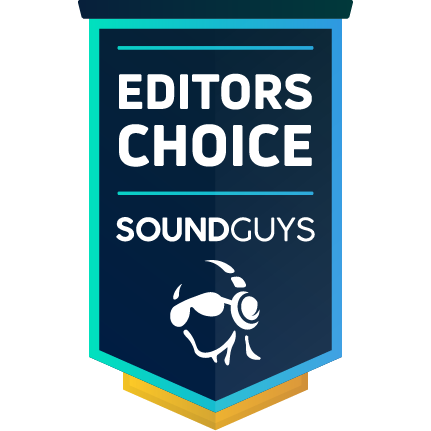


Any time a new set of active noise canceling (ANC) headphones gets released, it’s a big deal around here — especially when it challenges the current kings of the category. JBL’s latest headphones do just that: by making the most of the latest tech, the Apple AirPods Max is looking mighty long in the tooth. So which headphones come out on top in a matchup of JBL Tour One M3 vs. Apple AirPods Max? It’s complicated.
Editor’s note: this article was published on April 17, 2025, and is the first version of the article. Updates will follow as the market changes.
What’s it like to use the JBL Tour One M3 compared to the Apple AirPods Max?
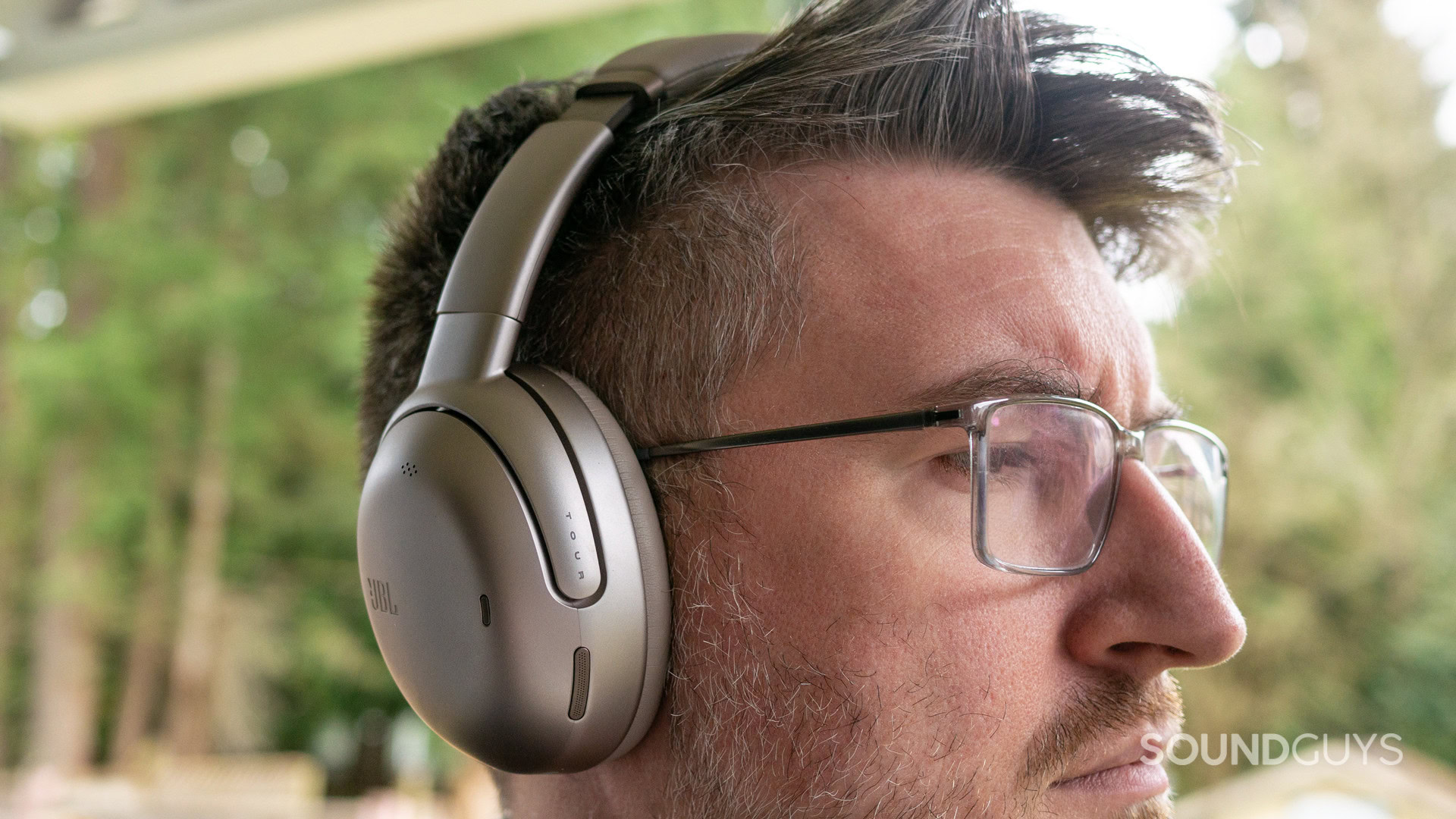
The JBL Tour One M3 is a light, mainly-plastic set of headphones with angled drivers, a fold-flat design, and padded band. The USB-C port both can charge or act as an input, as the internal DAC assembly is able to decode audio sent to it over USB. Additionally, the headphones come with what’s called the JBL SMART Tx accessory, which doubles as a remote and transmitter. If you want to listen to an analog source, you can use the included 3.5mm to USB cable to plug into the transmitter, and send the audio to multiple Auracast-enabled devices at once. The headphones are very comfortable, and the carrying case is very useful.
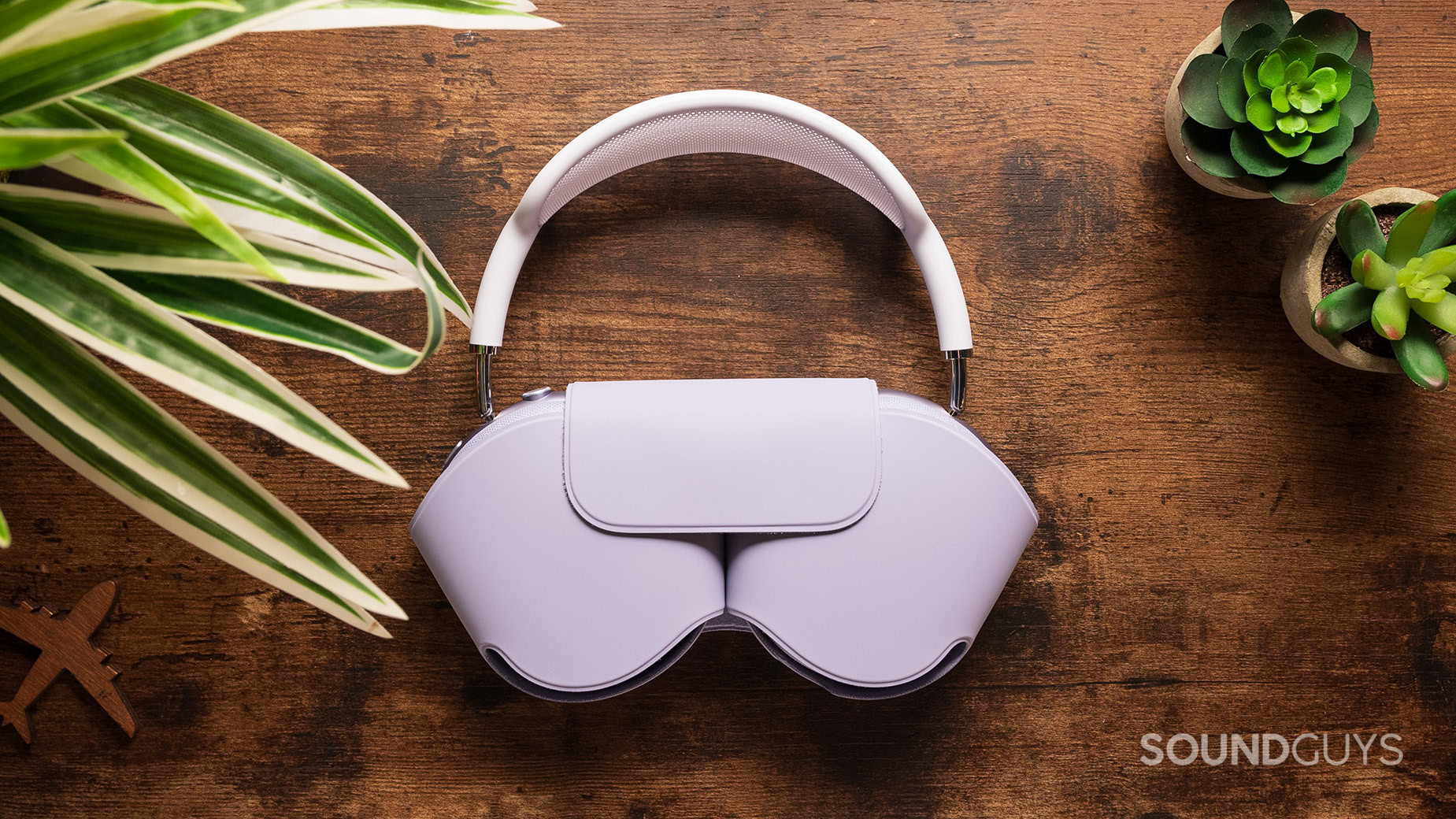
The Apple AirPods Max is a heavy, mainly-metal set of headphones, with ultra-deep ear cups, and mesh band. The latest USB-C version of the headphones primarily connect wirelessly over AAC, but after a firmware update: can now use the included USB cable to get lossless audio over a wired connection. The headphones distribute their mass well, and are comfortable. You can also take them apart quite well for maintenance purposes should something break. The Apple AirPods Max is primarily locked into the Apple ecosystem, as it relies on iOS for its advanced features. Still, it can be used with non-Apple hardware in a pinch — but not all features will work.
The JBL Tour One M3 can be controlled over the SMART Tx remote’s capacitive touchscreen, or you can use a mix of physical controls plus taps on the right ear cup:
| Input | Right earcup |
|---|---|
Single tap | Play / pause |
Double tap | Next track |
Triple tap | Previous track |
Long press | Voice assistant |
You can control the Apple AirPods Max with the digital crown knob and multifunction button:
| Action | Media controls | Call controls |
|---|---|---|
| Action Noise control button | Media controls Toggle ANC and Transparency mode | Call controls ✘ |
| Action Headset: remove/wear | Media controls Auto-pause/play | Call controls ✘ |
| Action Digital Crown: rotate | Media controls Adjust volume | Call controls ✘ |
| Action Digital Crown: one press | Media controls Play/pause | Call controls Answer/end call; answer incoming call and put current call on hold |
| Action Digital Crown: two presses | Media controls Skip track | Call controls Reject incoming call; answer incoming call and end current call |
| Action Digital Crown: three presses | Media controls Previous track | Call controls ✘ |
| Action Digital Crown: hold | Media controls ✘ | Call controls Reject second incoming call |
| Action Customizable controls? | Media controls Yes, ANC toggle only | Call controls No |
[/faq]
Do the JBL Tour One M3 or Apple AirPods Max have more features?
Both the JBL Tour One M3 and Apple AirPods Max have a ton of features, but they take two different tacks — the former is meant to be able to be compatible with just about anything, whereas the latter is meant to entice people into Apple’s walled garden. Though nobody will be disappointed with either headphones, if you don’t have an iPhone, iPad, or Mac: you’re going to probably want to stick with the JBL Tour One M3.

The Apple AirPods Max has a lot to offer, but features like the spatial audio, Find My, Automatic Switching, Audio sharing, and others are locked to devices running iOS. The JBL Tour One M3, on the other hand, is platform agnostic, and can even use the SMART Tx remote/transmitter to access core functions that are usually locked to an app. Though Apple does have an ever-increasing amount of features, JBL’s headphones are a bit more creative, and should be able to satisfy more people in and out of the Apple ecosystem. It’s a pain having to go without features simply because of which source you’re using, but the JBL Tour One M3 doesn’t suffer as much as the Apple AirPods Max in this regard.
How do the JBL Tour One M3 and Apple AirPods Max connect?

The JBL Tour One M3 has the benefit of needing to connect to a large range of devices to stay relevant in the market, and JBL ran with this one. You can listen over:
- USB-C audio (lossless).
- Analog unbalanced 3.5mm to USB-C (lossless).
- Auracast over the remote/transmitter accessory.
- Bluetooth (SBC, AAC, LDAC, LC3).
For the Apple AirPods Max, you can listen use the following:
- USB-C audio (lossless, after firmware update).
- Bluetooth (AAC).
Additionally, the SMART Tx remote/transmitter of the JBL Tour One M3 allows you to broadcast audio to multiple devices over LC3/Auracast from any analog or USB-C source. You cannot share audio with the AirPods Max in this fashion, though there is an iOS feature that allows broadcast to multiple devices.
Is battery life better on the JBL Tour One M3 or Apple AirPods Max?
The JBL Tour One M3 absolutely trounces the Apple AirPods Max in terms of battery life in the same conditions. At 55 hours and 37 minutes, the JBL Tour One M3 has over double the measured battery life of the Apple AirPods Max, which comes in at just over 20 hours of continuous music listening.
If you’re an intercontinental traveler, or simply hate recharging your headphones often: the choice is clear. Though Apple is known for its smart battery charging tech, the Apple AirPods Max’s internal battery also may not last as long as the one found in the JBL Tour One M3, as fewer charge cycles to full means a battery that lasts longer. It also means that less e-waste ends up where it shouldn’t, which is a nice plus.
Do the JBL Tour One M3 or Apple AirPods Max block noise better?
Loading chart ...
Interestingly enough, both the JBL Tour One M3 and Apple AirPods Max share a comparable amount of noise attenuation. Due to both designs’ reliance on deep earcups that do a decent job of meeting a human head, the isolation is quite good to begin with. This means that the ANC doesn’t have to cancel as much noise in the higher-end, which the technology isn’t amazing at. Both of these products scored an 8.7, meaning they reduced the overall perceived loudness by an average of 87% across the range of human hearing. Both are excellent noise canceling headphones, and neither really has the advantage here.
Loading chart ...
Both the JBL Tour One M3 and Apple AirPods Max also let you listen at a lower volume even in the presence of outside noise, which could help you avoid too much exposure to loud sounds. This, in turn, reduces the likelihood of noise-induced hearing loss. You can’t pick wrong between the JBL Tour One M3 and Apple AirPods Max if noise cancelation is your main concern.
Do the JBL Tour One M3 sound better than the Apple AirPods Max?
Both sets of headphones sound pretty good, but the JBL Tour One M3 requires some equalization to reach its full potential. The Apple AirPods Max does not.
Multi-Dimensional Audio Quality Scores (MDAQS)
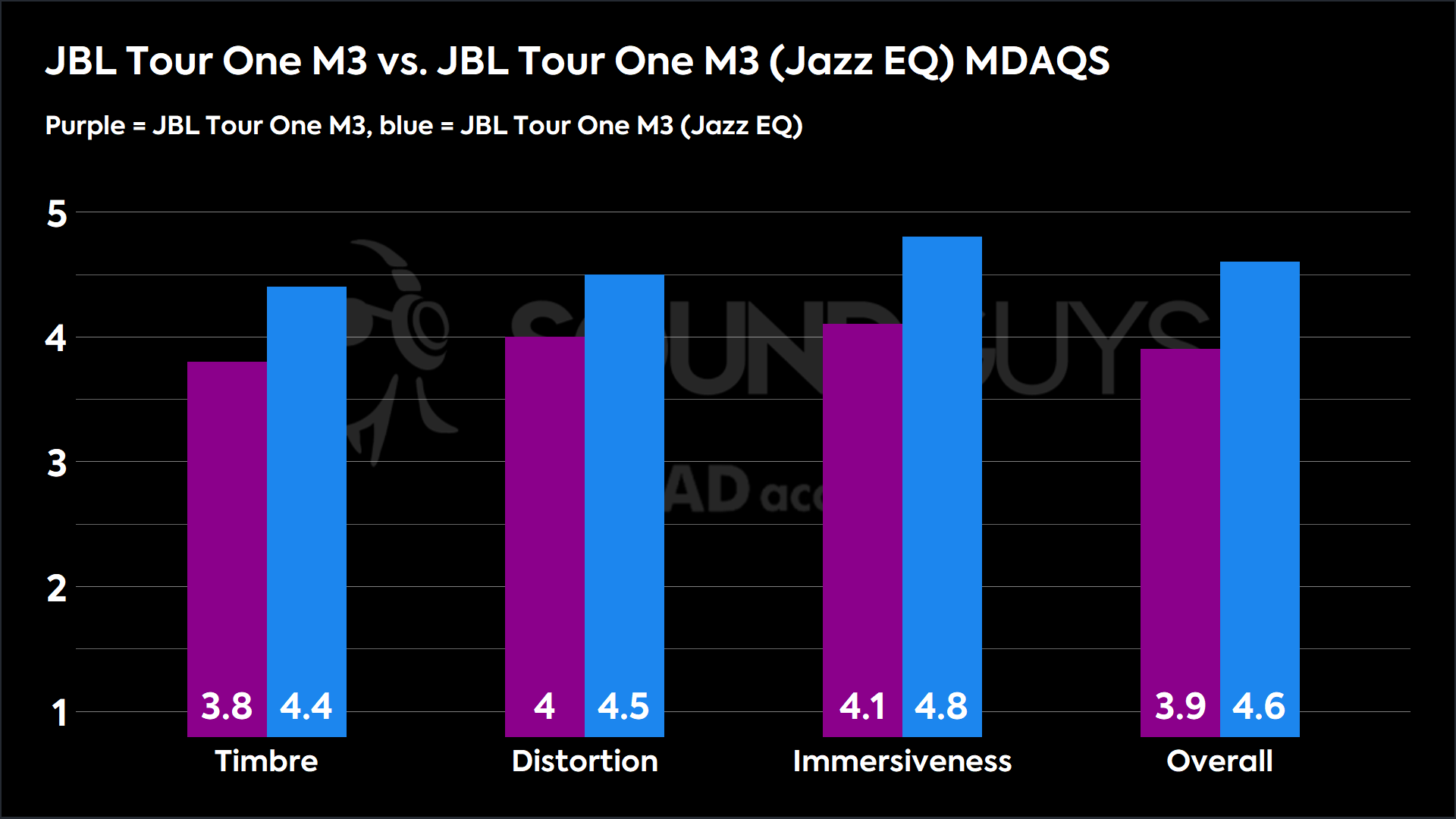
This is a bit complicated to unpack, because there’s such a wide variance in performance between different EQ modes of the JBL Tour One M3, and the Adaptive EQ feature of the Apple AirPods Max. The JBL Tour One M3 sounds fairly boring out of the box, and a bit dull. This is reflected in the purple scores below, and most people would call the sound “okay” to “good.” However, swapping to one of the other EQ presets will boost the mean opinion scores of these impressions considerably, as you can see the Jazz EQ preset in blue lands solidly in the “good” territory.
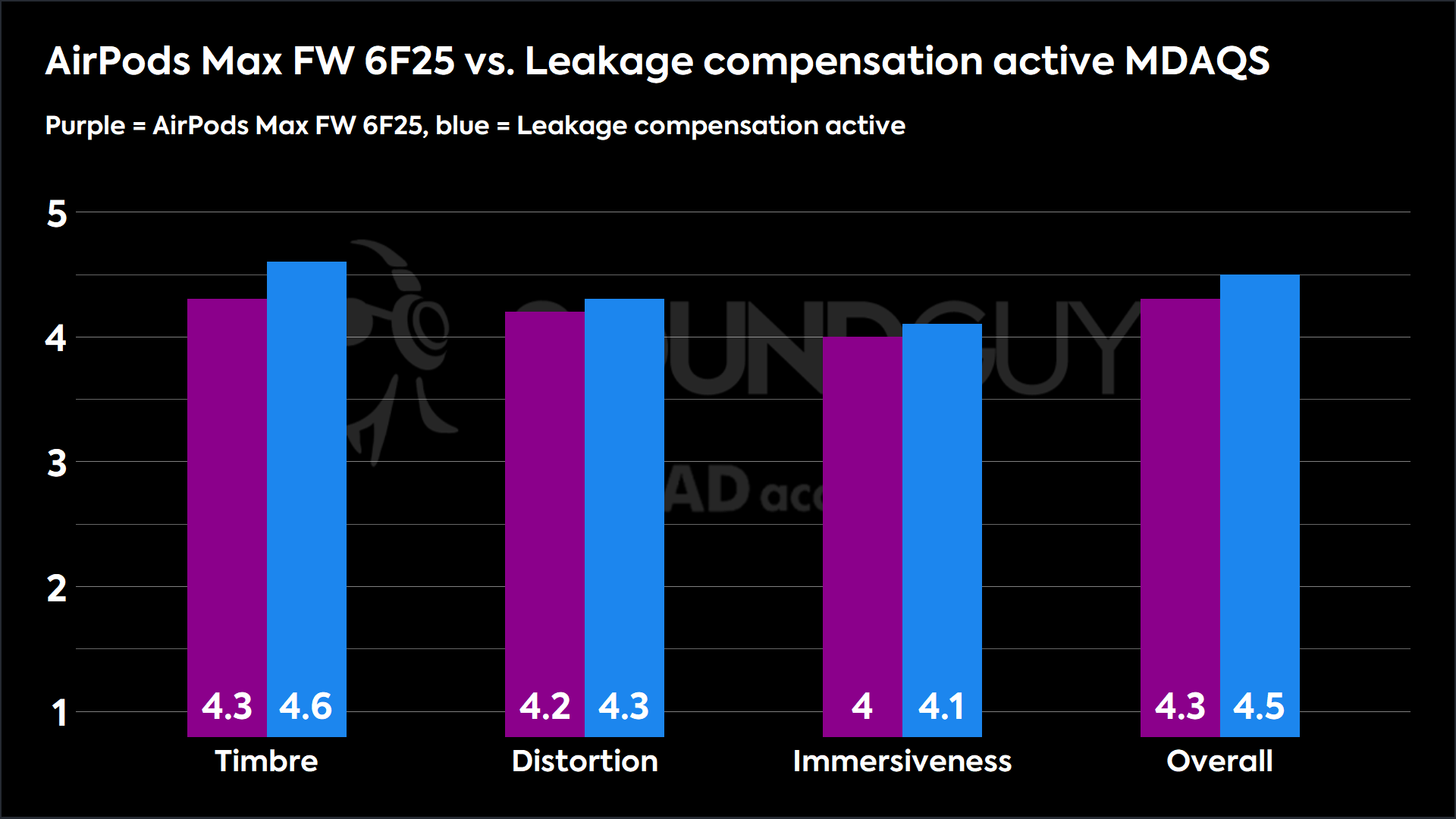
The Apple AirPods Max has its own performance variance, though not as huge. On the inside of the speaker grille, there’s a little microphone that helps the headphones cancel noise before it reaches your ear. However, this mic also doubles as a way to detect if your headphones aren’t fitted properly. Should this mic report that you have a poor seal, the Apple AirPods Max will adjust its frequency response so that the bass effectively remains the same at your eardrum assuming a good fit, and the range near 2-4kHz is bumped up to be a little more “normal” in our estimation. Users will likely find little fault with either response, but it’s something to be aware of.
- Timbre (MOS-T) represents how faithfully the headphones reproduce the frequency spectrum and temporal resolution (timing information).
- Distortion (MOS-D) represents non-linearities and added noise: higher scores mean cleaner reproduction.
- Immersiveness (MOS-I) represents perceived source width and positioning: how well virtual sound sources are defined in three-dimensional space.
Objective Measurements
Loading chart ...
First up, the JBL Tour One M3 does a decent job of sticking to the emphasis found in our preference curve in the lows and mids, but the highs get quite weird indeed. This leads to a very dull-sounding performance, as many important sounds for the illusion of space are a bit on the muffled side. But tinkering with the EQ presets will reward you with better user-attested responses and processing. The best-scoring preset in MDAQS, Jazz EQ, boosts both lows and highs to appeal to those who want a more energetic sound.
Loading chart ...
Here’s a more concrete example of what I was talking about earlier with Adaptive EQ. When the headphones detect a poor fit, the Apple AirPods Max will adjust its sound to compensate the bass and the 3kHz “ear gain” region. While this is a clever application, it does lead to some wonkery if you wear glasses or are somehow able to vacillate between a good fit and a poor fit. The differences in sound aren’t huge, and you may not even notice them — but they’re there.
Do the JBL Tour One M3 or Apple AirPods Max have a better microphone?
If you’re hoping to use your next headphones as a work or conference buddy, you’re going to want to have a decent microphone. Below we’ve included samples recorded in controlled conditions. Both seem to handle noise rejection well, but the difference between the two is never more stark than it is in windy conditions.
JBL Tour One M3 microphone demo (Ideal conditions):
Apple AirPods Max microphone demo (Ideal conditions):
JBL Tour One M3 microphone demo (Windy conditions):
Apple AirPods Max microphone demo (Windy conditions):
Which microphone sounds best to you?
JBL Tour One M3 vs Apple AirPods Max: Price and availability
As the JBL Tour One M3 just launched on April 14, 2025 for $399, it should be easy to find at electronics stores and online though you’ll likely not find it at a discount for quite a while. Conversely, Apple AirPods Max has been out for a while and can be found everywhere, although it hasn’t really come down much in price from its $549 MSRP.
Should you get the JBL Tour One M3 or Apple AirPods Max?
Most people will likely prefer the JBL Tour One M3 over the Apple AirPods Max because of its ability to be used with almost any source, old or new, and the fact that it only has to pay $400 instead of $550. But here’s the low-down anyway. If you still want more direction, you’re always welcome to see the broader picture among the best ANC headphones.
Choose the JBL Tour One M3 if:
- You want maximum compatibility.
- You want high-bitrate Bluetooth audio.
- You want to share your audio with others, regardless of platform.
- You’re looking for maximum battery life.
- You don’t want to spend any more than you have to.
Choose the Apple AirPods Max if:
- You’re already in the Apple ecosystem.
- It fits your head better.
- You don’t care about price.

20-hour battery life
Well-built pads
VS Product Z or alternative options
If you’re looking for viable alternatives to the JBL Tour One M3 or Apple AirPods Max, I advise you to wait. Truthfully, we’re overdue for new Sony flagship noise canceling headphones, and the Bose QuietComfort Ultra ($429 at Amazon) don’t have the same features that either of the headphones discussed here have — but perform about on-par. Should a successor to the Sony WH-1000XM5 ($387 at Amazon) be announced, you could either pounce on that model getting sold off at a bargain, or you could take a look at the new headphones.

Bargain-hunters may like the Sony ULT WEAR ($199.99 at Amazon), as it’s less than half the sticker price of the JBL Tour One M3, and it’s decent, to boot. It sounds fine, like previous iterations of the WH-1000XM line (the WH-1000XM4 in particular). But the main drawback to the headphones is that they are heavily dependent on the app to make the most of them.
Frequently asked questions
No.
Yes.
Yes, though the AirPods Max lose some features when used with non-iOS devices.
Yes, though the AirPods Max are a complete and utter pain to switch to non-iOS devices.
Both should be fine.
Yes.